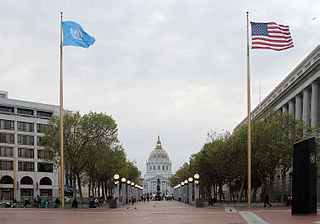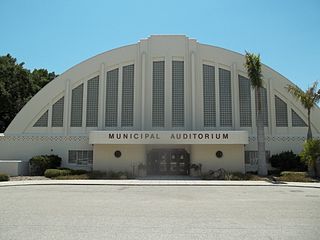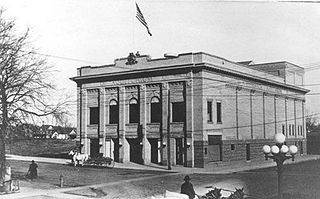
Bismarck is the capital of the U.S. state of North Dakota and the county seat of Burleigh County. It is the state's second-most populous city, after Fargo. The city's population was 73,622 in the 2020 census, while its metropolitan population was 133,626. In 2020, Forbes magazine ranked Bismarck as the seventh fastest-growing small city in the United States.

The Civic Center in San Francisco, California, is an area located a few blocks north of the intersection of Market Street and Van Ness Avenue that contains many of the city's largest government and cultural institutions. It has two large plazas and a number of buildings in classical architectural style. The Bill Graham Civic Auditorium, the United Nations Charter was signed in the Veterans Building's Herbst Theatre in 1945, leading to the creation of the United Nations. It is also where the 1951 Treaty of San Francisco was signed. The San Francisco Civic Center was designated a National Historic Landmark in 1987 and listed in the National Register of Historic Places on October 10, 1978.

The Sarasota Municipal Auditorium, listed in the National Register as Municipal Auditorium-Recreation Club, is a historic multi-purpose facility built-in 1938. It is located at 801 Tamiami Trail North and is owned/operated by the municipal government of Sarasota, Florida. The auditorium has 10,000 square feet (930 m2) of exhibit space on its main floor and also contains an Art Deco style stage measuring 1,500 square feet (140 m2).

The Deerwood Auditorium is a community center in Deerwood, Minnesota, United States. It was built as a New Deal project from 1935 to 1937. In 1995 the auditorium was listed on the National Register of Historic Places for its local significance in the themes of architecture, politics/government, and social history. It was nominated for being an exemplary multipurpose municipal building funded by the New Deal, as well as Minnesota's largest project by the State Emergency Relief Administration, and a longstanding venue for community events.
The Bismarck-Mandan Symphony Orchestra is a community orchestra based out of Bismarck, North Dakota, and performs in the Belle Mehus Auditorium.

The Pasadena Civic Center District is the civic center of and a historic district in Pasadena, California. The district is roughly bounded by Walnut and Green Streets and Raymond and Euclid Avenues.

Memorial Hall, or Soldiers and Sailors Memorial Building, is a multi-purpose auditorium located in Kansas City, Kansas. The 3,500-seat auditorium, which has a permanent stage, is used for public assemblies, concerts and sporting events. It was listed on the National Register of Historic Places in 1985. It was designed by architects Rose & Peterson in Georgian style.

The Ronald N. Davies Federal Building and U.S. Courthouse is a historic post office and federal office building located at Grand Forks in Grand Forks County, North Dakota, United States. It is a courthouse for the United States District Court for the District of North Dakota. Also and historically known as U.S. Post Office and Courthouse, the building is listed on the National Register of Historic Places under that name.
Currently there are 124 properties listed on the National Register of Historic Places in Central Chicago, out of more than 350 listings in the City of Chicago. Central Chicago includes 3 of the 77 well-defined community areas of Chicago: the historic business and cultural center of Chicago known as the Loop, as well as the Near North Side and the Near South Side. The combined area is bounded by Lake Michigan on the east, the Chicago River on the west, North Avenue on the north, and 26th Street on the south. This area runs five and one-quarter miles from north to south and about one and one-half miles from east to west.

The U.S. Post Office and Courthouse in Bismarck, North Dakota, United States, was built during 1912–13 and expanded in 1937. It was designed by James Knox Taylor and includes Late 19th and 20th Century Revivals architecture and Second Renaissance Revival architecture. Also known as Federal Building, it served historically as a courthouse and as a post office. The building was listed on the National Register of Historic Places in 1976.

Buechner & Orth was a St. Paul, Minnesota-based architectural firm that designed buildings in Minnesota and surrounding states, including 13 courthouses in North Dakota. It was the subject of a 1979 historic resources study.

The Blackfoot LDS Tabernacle, also known as the Blackfoot Tabernacle or South Blackfoot Stake Tabernacle is a building located in Blackfoot, Idaho that formerly served as a tabernacle for large gatherings of members of the Church of Jesus Christ of Latter-day Saints. The tabernacle was designed by architects Hyrum Pope and Harold W. Burton and completed in 1921. The building was listed on the National Register of Historic Places in 1977. In 1980 the church sold the building to the city of Blackfoot. It was used as a civic auditorium until the 90's and sat until 2003. In 2003 local business owner Perry Hawker bought it and it now functions as the Hawker Funeral Home.

William F. Kurke (1889–1965) was a prolific architect in North Dakota.

Arthur Wesley Van Horn was a prolific architect of Bismarck, North Dakota. A number of Van Horn's works, alone or as part of his firm, are listed on the U.S. National Register of Historic Places.

The Downtown Bismarck Historic District is a 40-acre (16 ha) historic district in Bismarck, North Dakota that was listed on the National Register of Historic Places in 2001. It includes work by architect Arthur Van Horn and others. The listing included 40 contributing buildings.
Edward Emmett Dougherty, a.k.a. Edwin Dougherty was an architect in the southeastern United States. One of his best known designs was the Tennessee War Memorial Auditorium in Nashville in 1922. The work won state and national design competitions.

The Carson City Civic Auditorium, at 813 N. Carson St. in Carson City, Nevada, was designed by architect Lehman A. Ferris and was built during 1938–39. It was funded by a municipal bond and by the Public Works Administration. Also known simply as Municipal Auditorium, it was listed on the National Register of Historic Places in 1990. Since 1994, the building has served as the location for the Children's Museum of Northern Nevada.

The Town Hall of Sandwich, New Hampshire, is located at 8 Maple Street in the village of Center Sandwich. Built in 1913, it is a handsome example of Colonial Revival architecture, and has been a prominent focal point of the town's civic and social life since its construction. The building was listed on the National Register of Historic Places in 1980.

Stevens Memorial Hall is the historic town hall of Chester, New Hampshire. The building, a large wood-frame structure completed in 1910, is located in the center of Chester at the junction of New Hampshire Routes 121 and 102. The building was listed on the National Register of Historic Places in 2004. It served as the center of the town's civic business until 2000, when town offices were relocated to a former school.



















